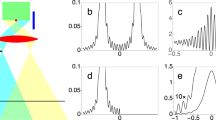Abstract
Some modified two-slit interference experiments were carried out showing an apparent paradox in wave–particle duality. In a typical such experiment, the screen, where the interference pattern is supposed to be formed, is replaced by a converging lens. The converging lens forms the images of the two slits at two spatially separated detectors. It was claimed that each of these two detectors give information about which slit a photon came from, even though they come from the region of interference. These experiments generated a lot of debate. The various refutations pointed out that the controversial claims involved some questionable assumptions. However the refutations were largely philosophical in nature, and one may like to substantiate those with arguments which are testable, at least in principle. Here such an experiment is theoretically analyzed by introducing path markers which are two orthogonal polarization states of the photon. Analyzing the polarization at the two detectors shows that the photons which give rise to interference, and reach a particular detector, always come from both the slits. This provides clarity in understanding such experiments by making use of testable quantum correlations.



Similar content being viewed by others
References
Bohr, N.: The quantum postulate and the recent development of atomic theory. Nature (London) 121, 580 (1928)
Feynman, R.P., Leighton, R.B., Sands, M.: Lectures on Physics, vol. 3, pp. 1-1. Addison-Wesley (1966)
Qureshi, T., Vathsan, R.: Einstein’s recoiling slit experiment, complementarity and uncertainty. Quanta 2, 58 (2013)
Qureshi, T.: Predictability, distinguishability, and entanglement. Opt. Lett. 46, 492 (2021)
Roy, A.K., Pathania, N., Chandra, N.K., Panigrahi, P.K., Qureshi, T.: Coherence, path predictability, and I concurrence: a triality. Phys. Rev. A 105, 032209 (2022)
Afshar, S.S., Flores, E., McDonald, K.F., Knoesel, E.: Paradox in wave-particle duality. Found. Phys. 37, 295 (2007)
Flores, E.V.: Modified Afshar experiment: calculations. In: Roychoudhuri, C., Kracklauer, A. F., Khrennikov, A.Y. (eds) The Nature of Light: What are Photons? III Proc. SPIE, vol. 7421, pp. 74210W. San Diego, SPIE (2009)
Chown, M.: Quantum rebel. New Sci. 183, 30 (2004)
Kwiat, P.G., Weinfurter, H., Herzog, T., Zeilinger, A., Kasevich, M.A.: Interaction-free measurement. Phys. Rev. Lett. 74, 4763 (1995)
Kastner, R.E.: Why the Afshar experiment does not refute complementarity. Stud. Hist. Philos. Sci. B 36, 6498 (2005)
Srinivasan, R.: Logical analysis of the Bohr Complementarity Principle in Afshar’s experiment under the NAFL interpretation. Int. J. Quantum Inf. 8, 465 (2010)
Drezet, A.: Wave particle duality and Afshar’s experiment. Progress Phys. 7(1), 57 (2011)
Steuernagel, O.: Afshar’s experiment does not show a violation of complementarity. Found. Phys. 37, 1370 (2007)
Georgiev, D.D.: Single photon experiments and quantum complementarity. Progress Phys. 2, 97–103 (2007)
Flores, E.V.: Reply to comments of Steuernagel on the Afshar’s experiment. Found. Phys. 38, 778 (2008)
Jacques, V., Lai, N.D., Dréau, A., Zheng, D., Chauvat, D., Treussart, F., Grangier, P., Roch, J.-F.: Illustration of quantum complementarity using single photons interfering on a grating. New J. Phys. 10, 123009 (2008)
Qureshi, T.: Modified two-slit experiments and complementarity. J. Quantum Inf. Sci. 2, 34 (2012)
Flores, E.V., De Tata, J.M.: Complementarity paradox solved: surprising consequences. Found. Phys. 40, 1731 (2010)
Kaloyerou, P.N.: Critique of quantum optical experimental refutations of Bohr’s principle of complementarity, of the Wootters-Zurek principle of complementarity, and of the particle-wave duality relation. Found. Phys. 46, 138 (2015)
Knight, A.: No paradox in wave-particle duality. Found. Phys. 50, 1723 (2020)
Gergely, B., Batelaan, H.: Simulation of Afshar’s double slit experiment. Found. Phys. 52, 69 (2022)
Scully, M.O., Drühl, K.: Quantum eraser: a proposed photon correlation experiment concerning observation and “delayed choice’’ in quantum mechanics. Phys. Rev. A 25, 2208 (1982)
Walborn, S.P., Terra Cunha, M.O., Pádua, S., Monken, C.H.: Double-slit quantum eraser. Phys. Rev. A 65, 033818 (2002)
Acknowledgements
The authors wishes to thank the two anonymous referees for their various suggestions which led to much improved clarity and readability of the paper. The author is thankful to Alexandra Elbakyan for her support.
Author information
Authors and Affiliations
Corresponding author
Ethics declarations
Conflict of interest
The author has no conflict of interest.
Additional information
Publisher's Note
Springer Nature remains neutral with regard to jurisdictional claims in published maps and institutional affiliations.
Rights and permissions
Springer Nature or its licensor (e.g. a society or other partner) holds exclusive rights to this article under a publishing agreement with the author(s) or other rightsholder(s); author self-archiving of the accepted manuscript version of this article is solely governed by the terms of such publishing agreement and applicable law.
About this article
Cite this article
Qureshi, T. Understanding Modified Two-Slit Experiments Using Path Markers. Found Phys 53, 38 (2023). https://doi.org/10.1007/s10701-023-00684-z
Received:
Accepted:
Published:
DOI: https://doi.org/10.1007/s10701-023-00684-z




